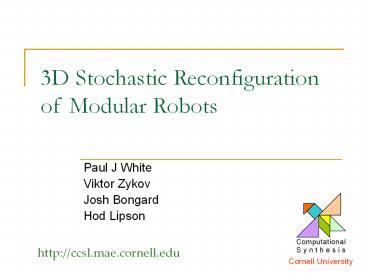3D Stochastic Reconfiguration of Modular Robots - PowerPoint PPT Presentation
Title:
3D Stochastic Reconfiguration of Modular Robots
Description:
3D Stochastic Reconfiguration of Modular Robots – PowerPoint PPT presentation
Number of Views:108
Avg rating:3.0/5.0
Title: 3D Stochastic Reconfiguration of Modular Robots
1
3D Stochastic Reconfiguration of Modular Robots
- Paul J White
- Viktor Zykov
- Josh Bongard
- Hod Lipson
http//ccsl.mae.cornell.edu
Cornell University
2
Motivation Adaptive Morphology
- Robotic adaptation in nature involves
changing/learning morphology, not just control - Over robot lifetime (behavior)
- Over evolutionary time (design)
3
Evolution of morphology control
4
Evolution of morphology control
5
Transfer to reality
6
Printed Active Materials
Some of our printed electromechanical /
biological components (a) elastic joint (b)
zinc-air battery (c) metal-alloy wires, (d) IPMC
actuator, (e) polymer field-effect transistor,
(f) thermoplastic and elastomer parts, (g)
cartilage cell-seeded implant in shape of sheep
meniscus from CT scan.
With Evan Malone
7
Motivation Adaptive MorphologyModular robotics
- Robotic adaptation in nature involves
changing/learning morphology - Over robot lifetime and evolutionary time
- Scaling number of units (1000s)
- Greater morphological flexibility (space)
- Better economical advantage
- Micro-scale
- No moving parts, no onboard energy
- Scalable fabrication, scalable physics
8
A Dichotomy
Modular Robotics high complexity, do not scale
in size
Stochastic Systems scale in size, limited
complexity
- Murata et al Fracta, 1994
- Murata et al, 2000
- Jørgensen et al ATRON, 2004
- Støy et al CONRO, 1999
- Fukuda et al CEBOT, 1988
- Yim et al PolyBot, 2000
- Chiang and Chirikjian, 1993
- Rus et al, 1998, 2001
- Whitesides et al, 1998
- Winfree et al, 1998
9
Simulation
10
Proposed Stochastic System
- No independent means of power or locomotion
- The units are passive, only draw power when
attached to growing structure - Modules are driven by (artificial and natural)
Brownian motion - Structure reconfigures by manipulating local
attraction/repulsion field near bonding sites - Passive motion is natural for small scale
implementations
11
Stochastic Self Reconfigurable Systems
- White et al, 2004
- Two Solid-state, 3D implementations
12
Implementation 1
Permanent magnets embedded inside of the cube
walls
Electromagnet
Spring loaded contacts for distributing power
communication
Embossed patterns on all faces ensure proper
alignment
Basic Stamp II controller
Power storage 0.28 F capacitor for switchable
bonding
(b)
13
Experiment Environment
- Oil medium agitated by
- Fluid flow by external pump
- Mechanical disruption of fluid
- Substrate with attracting bonding site
14
Implementation 1 Magnetic Bonding
15
Implementation 1 Magnetic Bonding
16
Beneficial System Properties
- Reconfigurable
- Programmable
- Homogeneous/simple units
- 3D modules 6 d.o.f.
System Disadvantages
- Permanent magnets create undesired bonds
- Electromagnets require local power storage
- Viscous medium requires high actuation power
- Electromagnetic bonding and actuation does not
scale
17
Proposed Scalable Solution
F A ?P
Fluid Flow
?P
Valves allow for selectable bonding
Substrate
To external pump
18
Construction Sequence
19
Construction Sequence
20
Construction Sequence
21
Construction Sequence
22
Construction Sequence
23
Construction Sequence
24
3D Structures
25
3D Structures
26
Implementation 2
Embossed fluid manifold
- Inside of the cube
- Servo- actuated valves
- Basic Stamp II controller
- Central fluid manifold
- Communication, power transmission lines
Hermaphroditic interface
Orifices for fluid flow
27
Implementation 2 Fluidic Bonding
Movie accelerated x16
28
Conclusion
- 3D stochastic modular robotic system
- In two implementations
- More scalable to microscale
- A substrate with interesting algorithmic
challenges - the factors that govern the rate of assembly and
reconfiguration - the effects of larger quantities of modules on
the system































